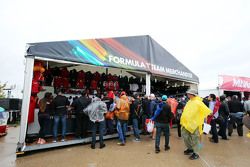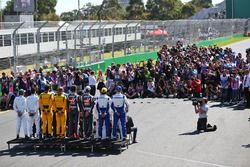Analysis: Turning a Formula 1 GP into a festival
With ever increasing entertainment options available, F1 GPs are having to offer fans more and more to keep up with customer expectations. The CEOs of COTA and Albert Park speak to Motorsport.com about the tricks they have up their sleeves.

Photo by: XPB Images















While the paddock waits with bated breath to see what changes - if any - new owners Liberty Media will introduce for the 2017 season, for the moment the sense is one of cautious optimism.
There are no suggestions that the baby will be thrown out with the bathwater, but there is also widespread hope that some changes will be made.
Both Liberty Media and new sport sponsors Heineken have made much of improving fan access to the sport, and of a focus on social media, better activation, and widespread promotion of the sport outside of race weekends.
As things stand right now, however, F1's race promoters are treating 2017 as business as usual, with each promoter working on improving their individual offerings without a wider guiding ethos from the sport's new influencers.
COTA CEO Bobby Epstein has yet to sit down with the Liberty Media executives to talk about the options available to the United States' only purpose-built F1 circuit in future, but the American businessman is looking forward to having additional support when it comes to promoting Formula 1 around the US in years to come.
"Well, since we're right in their backyard here, we hope that we're doing things that [Liberty Media] would look at and say, 'these guys are doing some things that might be good for the sport all around the globe'.
"[The hope is that they will] try and apply the best of what we do here to the sport overall, but by the same token that they do the same with other races around the world and bring those experiences to us.
"One of the biggest areas that we do mention that could make a big difference [to COTA] is the marketing budget," Epstein continued. "Right now the way that it works is we are the marketing arm of F1 in the US, which is really taxing on a venue."
On the other side of the planet, Andrew Westacott, CEO of the Australian Grand Prix Corporation, is focussing on making the Melbourne season opener the best it can be - a process that has been underway since the chequered flag fell on the 2016 race - and has yet to begin any dialogue with the new owners about the shape of the sport in future.
"At the moment for us, we're the first race of next season, first cab off the rank, so it's all business as usual. We read what's out there and we just put our heart and soul into doing what's best for the fan and for the sport. If that appears to be what it is in the direction of the new owners then we think that's fantastic as well, but for us it is business as usual.
"We're talking about what we do and wanting to enhance things like The Melbourne Walk and the Fan Forum," Westacott continued.
"If it can be broadened to get an [expansion] of social media use or a broadening of the footprint of Formula 1, then that is going to benefit the sport and the reason why Melbourne hosts it: to promote our city."
One thing that both Melbourne and Austin have in common is that the two cities are well-accustomed to hosting large-scale events. Melbourne is Australia's capital of sport, and plays host to not only the F1 grand prix but also the Australian Open and the Melbourne Cup, to name but a few.
Austin is synonymous with the South-By-Southwest (SXSW) Festival, which attracts tens of thousands of people per year, and regular collegiate sports games that draw similar figures.
In such a crowded market, Formula 1 needs to assert itself to stand out from the crowd, and both Austin and Australia have made a point of creating events beyond the racetrack, offering ticket-holders a festival experience to provide ultimate bang for buck.
"We know that people love coming along," Westacott said, but we also know that they are looking for "value for money in a very, very crowded events market in Melbourne, so we have got to do things to cater for [a range of] demographics.
"What families want is completely different to the young event-goer. So for families we have things like a Disney section, we have a Porsche kids driving school, and we have a sports activity zone.
"We have had BMX and we have had Tony Hawk and the Crusty Demons and Nitro Circus, and at the moment we're working around what we are going have in a similar style [for 2017]. We do that on Thursday, Friday, Saturday and Sunday in a marquee two or three times a day to cater for it.
"So dad wants to come along or it might be that two of the dads get to bring half a dozen kids and it's a bit of a mix and match. There are things to do for the kids, and there are things for the dad.
"For the young event-goers, Melbourne is synonymous with good coffee, laneways, music, street art, food vans, and some really good food. What we created [in 2016] was a thing called M Lane. M Lane was a recreation of Melbourne's laneways and street culture.
"That really showed the way we had to market to that segment, the young event-goers: it was completely different to the way our guys had to market to the motoring enthusiast."
Over in the northern hemisphere, Epstein has also found that changing the nature of the off-track offering has helped boost ticket sales by making the race a family affair, rather than an event designed purely for the die-hard petrolhead.
"Last year we had Elton John, which was fantastic, but he appealed somewhat to the existing audience," Epstein acknowledged.
"This year [with Taylor Swift and The Weeknd] we're seeing ... that it's not just the male F1 fan that's coming, it's the family, and the women have a reason to come, the kids have a great reason and hopefully it creates that family experience that I think a lot of people are looking for with their entertainment.
"One thing we'd like to see by the tenth year is an increase in what is already a growing number of people who make it an annual tradition to come to the United States Grand Prix in Austin, because we're starting to see that develop and we wanna see it pass on in the family.
"So, I think that to see that increase every year and see the same people coming back means that we're doing something right."
Be part of Motorsport community
Join the conversationShare Or Save This Story
Subscribe and access Motorsport.com with your ad-blocker.
From Formula 1 to MotoGP we report straight from the paddock because we love our sport, just like you. In order to keep delivering our expert journalism, our website uses advertising. Still, we want to give you the opportunity to enjoy an ad-free and tracker-free website and to continue using your adblocker.















Top Comments